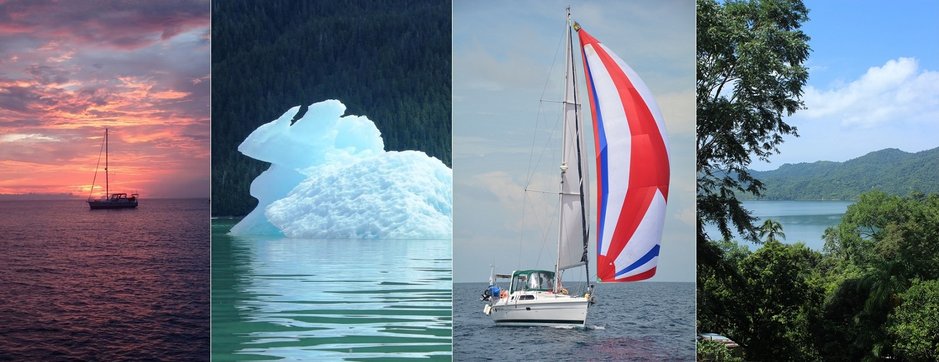Today we awoke earlier than we thought we might given the time change. But then we were in bed at 8pm and got up at 9am. So after only getting 4 hours sleep on the plane, sleeping 12 or 13 hours was refreshing. We went to the rooftop for breakfast.
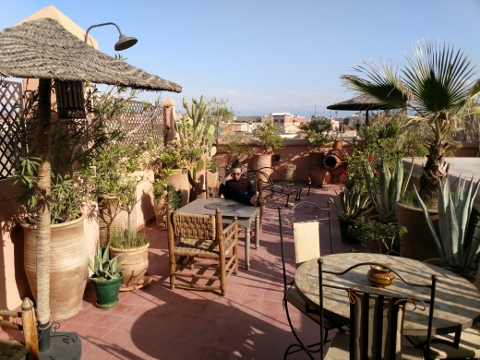
We found that Riad Miski’s chef had cooked Melissa a sweet cake from rice flour and honey and shredded coconut. OMG. Melissa is in heaven. She has not had a sweet coffee cake for years. Plus, there was more of the rice flour bread. Along with plenty of coffee for Dave and Moroccan mint tea for Melissa. Ok, feeling spoiled now.
Now off to the souks (markets). We had heard that in the countryside you have to be careful about picture taking because the locals still believe that you can steal their souls by taking a picture of them, but in the modern cities, it was all fine. Yeah. Not so much. First picture Melissa tried to take of a local was a meat market vendor. Similar to the picture below.
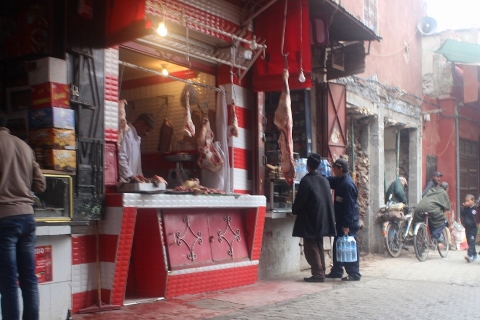
But she made the mistake (?) of asking permission. The very traditional vendor, in his Fez hat, started to speak in Arabic. Melissa held up the camera a second time and said, “is ok?”. At which point he gave her the finger and started yelling with eyes like daggers. Yeah, ok, message received, pretty sure that was a “no”. And no idea what he was yelling in Arabic but was probably some version of “Infidel!”. Gulp. Ok, note to self, no pictures of the locals. Well, no pictures that they know about anyway. So therein began Melissa’s secret mission to take pictures. She carried the camera everywhere with both hands on it as if to protect it from being stolen. But in reality, she was clicking away. Thank goodness for auto-focus.
At first she took a few that weren’t quite level.
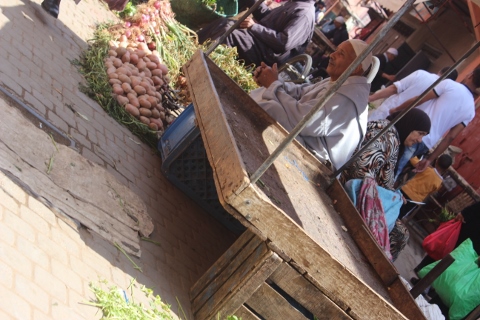
But after that she got a bit better at it.
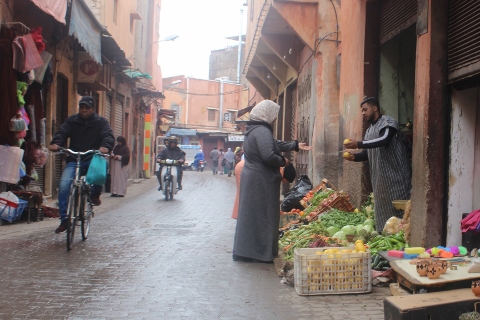
We had a map and a set of directions given us by our hosts. But in these narrow little winding streets we managed a wrong turn. Instead of heading to the markets and main square, we ended up in the Tannery district. Which given that they use cow urine and pigeon poop to treat the leather means it’s not exactly the most pleasant of areas shall we say. Good thing our hosts had told us that we were safe anywhere within walking distance otherwise all the “friendly” locals would be a bit more intimidating. They will “help” direct you to their favorite tannery for a tour, or to “help” you find a shop or the main square. They will talk to you in English first, but if they don’t get a response they are unrelenting and will just keep talking and asking you what language you speak. If you speak a word of Spanish – they’ll start to chatter in Spanish. A word of French – and you get French. Amazing actually that so many are fluent in so many languages. It’s common for the locals to know five languages – Arabic, French, English, Berber, and Spanish. But it can get a bit old when you would like to just enjoy the scenery. Eventually we found our way round to the souks.
Everywhere there was a mass of humanity. As Europeans often vacation in Morocco, you find people of lots of different nationalities all mixed together. The shopkeepers are as aggressive as the “helpful tour guides” on the streets. They will try any ploy to get you to look at their wares. If you so much as looked at a scarf a shopkeeper would have one wrapped around you before you could blink. As a friend said, if haggling were an Olympic sport, the Moroccans would take the gold every time. So, we wandered around quite a while before attempting to actually buy anything just to get the feel of the place.
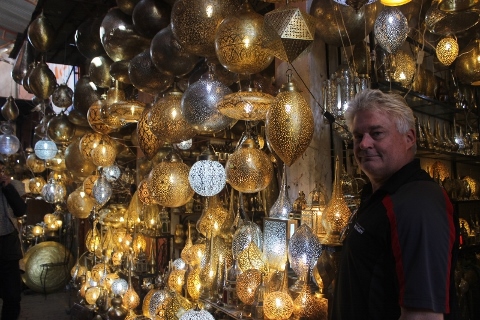
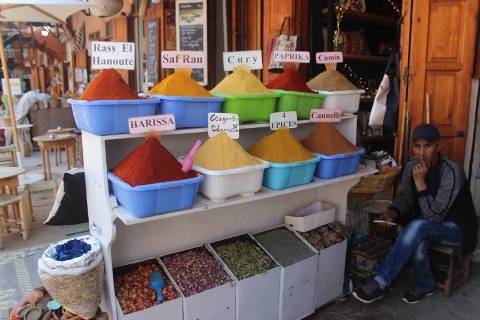
These are different types of paint pigments.
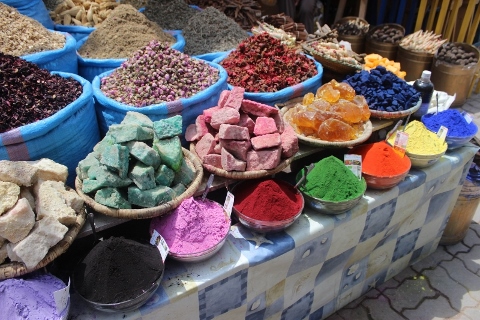
I sort of suspect they might have been used to color these baskets.
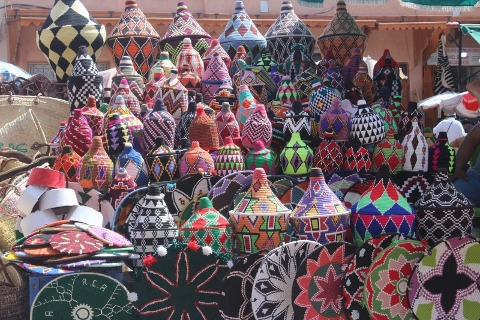
Interestingly we see tons of cats here, but very few dogs. There are stray kittens everywhere.
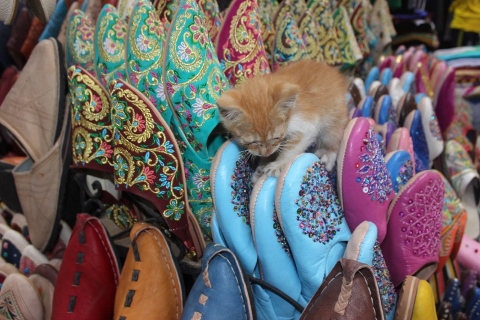
When we got to the main square, Melissa got fascinated by the snake charmers and took some pictures. That was a mistake. Within seconds Dave had a snake wrapped around his neck. Which was fine - we’ve dealt with snakes before (those who read this blog closely might remember the boa that our guides caught for us in the Amazon). Problem is that we didn’t pre-negotiate the price. Big mistake. Cost us $30 when the going rate is about $3. Ooops. Rookie mistake.
We bought some really yummy giant dates.
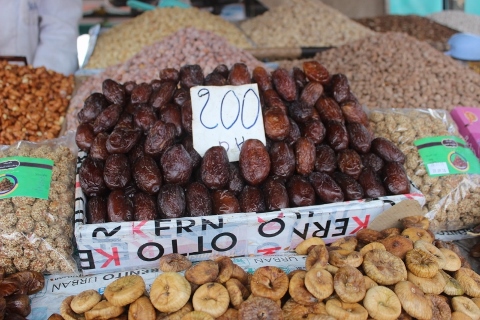
The other thing to watch out for in the shops is all the counterfeiting that goes on. Melissa found a number of shops selling what looked like fossils (all the fossils in the picture below are quite likely fake). One offered a trilobite for $20. Yeah right. A good quality trilobite should cost $1000+. Saffron and silver are also often counterfeit. Melissa bought a pair of earrings for $2 but didn’t even pretend they were real. And at a starting price of $2 – didn’t even bother to haggle.
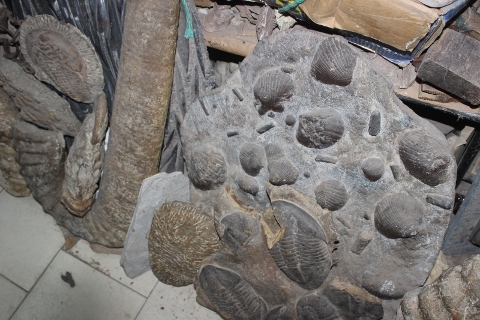
Dave bought two belts for $5 each (down from $20 each) after haggling with a street vendor that chased him through the souks for quite a while. And Melissa bought a Tagine for $30 without too much haggling – down from the offering price of $60. Whatever they offer, counter at 1/3 and settle at 1/2 is about the way things roll.
There was one shop where we didn’t haggle though – the spice shop. We wandered in and a very polished sales person – Ahmed – saw us observing them making argan oil. Used for both cooking and cosmetics – its quite a process to make it – and hence pretty expensive. You have to crack the fruit open, get the nut out, then crack the nut open to get to the center where there is what looks like an almond. This is then roasted, and ground. The paste is the worked by hand till all the oil is driven out of the paste. The gal in the shop who was making it didn’t want her picture taken, so instead they offered to let Melissa grind while Dave took pictures.
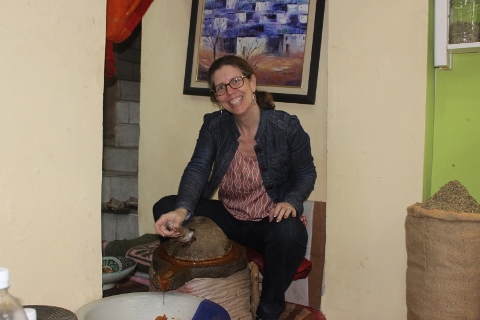
Then the guy led us around the shop telling us about all sorts of herbs and spices. We ended up buying some stuff that he swore would make Dave stop snoring (for $2 its worth a try!). And some spices to bring home. All in all, it was a really nice shop and we would gladly have gone back there again. We probably could have negotiated the spices down a bit, but they offered a fair price and we got our money’s worth in entertainment.
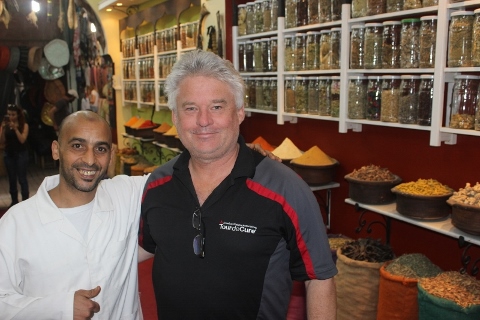
Then on our way back through the local’s district, Melissa finally found some scarves at a street vendor that were what she was looking for – nice and light – not like the heavy (but beautiful) woven scarves in most of the souks. She bought two for $3 each. Perfect because we’ve heard that when we get out into the countryside dress is much more conservative and its recommended that women cover their heads. Here in Marrakesh there is such a mix of humanity that you see the same summertime clothes you would anywhere in the US or Europe – women in short skirts and short sleeved shirts, men in shorts and t-shirts. However, it was interesting that as soon as Melissa donned the scarf on her head, the locals didn’t harangue us so much, and the men would sometimes nod in approval. Ok, so on the one hand, we like showing respect for other cultures. And if wearing the scarf makes life easier – its totally worth it. On the other hand, we’ve seen boys walking around playing and having fun, but you very rarely see any girls. And women simply don’t have anything other than cleaning or menial jobs here. We’ve yet to see a local woman in any job where she would have to deal with the public. You find a few foreigners – like we saw one restaurant cashier that clearly wasn’t a local female. But that was it. So, there’s a debate over whether to not wear the scarf in pure defiance of a culture that is so one-sided. For now, Melissa decides to wear it as respect wins out over annoyance – but we’ll see if that carries through the whole trip.
We stopped and had lunch at a small restaurant. Meatball (kofta) tagine with an egg. It was delish.
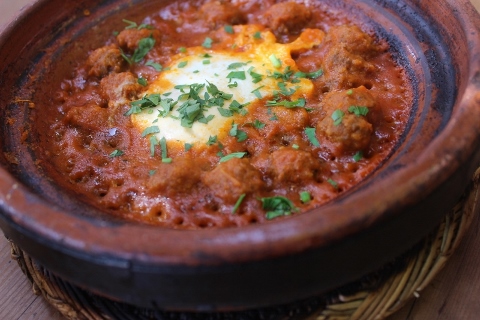
We were back at the Riad in the late afternoon, just in time for our hammam. A hammam is an Islamic tradition – a hot steam bath followed by a massage. Sounds like something we would do back home at the spa. But not quite the same. Most hotels have a room for this built into the facility. A small room with stone walls that is heated and steamy with a big sink like thing at one end with a faucet. We lay on the stone benches which were covered with a thick mat (something like a yoga mat). An attendant then scooped bowl-fulls of warm water and pours them on us. She the soaped us, more bowls of water, and then scrubbed with a mitten that is something akin to a stiff terry cloth to defoliate us. At one point she poked at me to look over at Dave – and he was peeling like a snake losing its skin. Then more soap and water. Then she covered us in mud and left us to soak for 10 minutes. Then we sat up and she shampoos our hair. At the end she dried us off with a towel. Mind you – we were both without a stich of clothing. And the attendant had stripped to her underwear. A bit of a shocker when all day we have only seen local women if they were covered from head to toe – and never without the ever-present scarf covering their hair. In the public hammams, in the women’s bath there is a female attendant, and in the men’s bath, a male attendant. However, in the hotels (very possibly just for the foreigners) a single attendant deals with couples. Then she moved us to the massage room and we each got an hour long massage to rid us of the rest of the stiffness from the long trip here. Yes, again buck naked. And without the polite sheet draping business we have in massages back home. Apparently, the locals do this once a week. Ok, maybe we need to do this again while we are here. Cuz once you get over the shock factor – its amazing how pampered you feel.
Dinner was veal tangia, not to be confused with tagine. Tangia was originally a dish prepared by and for working men. Traditionally a group of artisans would pitch in the day before to buy all the necessary ingredients for tangia, then take it late evening or early morning to the fernatchi, the person in charge of the communal oven. These ovens are typically located adjacent to public hammams. The fernatchi would settle the tangia into smoldering ashes and leave it to cook throughout the night or early part of the day. At lunch time, when the shops were closed, the group of artisan friends would enjoy their tangia along with the famous Moroccan mint tea. Yumo.
